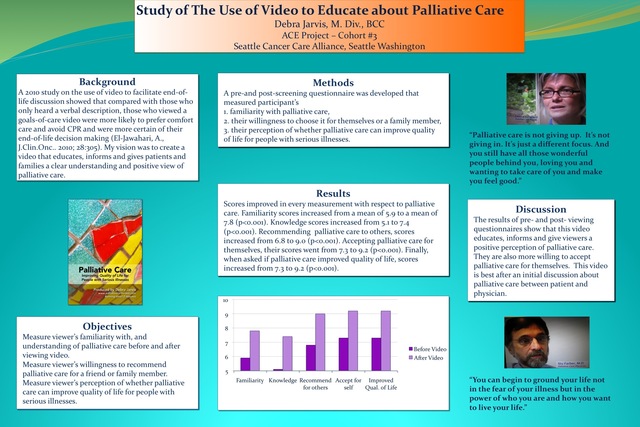Study of The Use of Video to Educate about Palliative Care

Abstract: The Use of Video to Educate about Palliative Care
Video: Palliative Care: Improving Quality of Life for People with Serious Illnesses
Produced by Debra Jarvis
Background: A 2010 study on the use of video to facilitate end-of-life discussion showed that compared with those who only heard a verbal description, those who viewed a goals-of-care video were more likely to prefer comfort care and avoid CPR and were more certain of their end-of-life decision making (El-Jawahari, A., J.Clin.Onc.. 2010; 28:305). My vision was to create a video that educates, informs and gives patients and families a clear understanding and positive view of palliative care.
Objectives
1. Measure viewer’s familiarity with, and understanding of palliative care before and after viewing video.
2. Measure viewer’s willingness to recommend palliative care for a friend or family member.
3. Measure viewer’s perception of whether palliative care can improve quality of life for people with serious illnesses.
Methods:
A pre-and post-screening questionnaire was developed that measured participant’s
1. familiarity with palliative care,
2. their willingness to choose it for themselves or a family member,
3. their perception of whether palliative care can improve quality of life for people with serious illnesses.
The questionnaires were given to 37 people and the statistical difference between the pre- and post-test sample was measured using the Students T test.
Results:
Scores improved in every measurement with respect to palliative care. Familiarity scores increased from a mean of 5.9 to a mean of 7.8 (p<0.001). Knowledge scores increased from 5.1 to 7.4 (p<0.001). Recommending palliative care to others, scores increased from 6.8 to 9.0 (p<0.001). Accepting palliative care for themselves, their scores went from 7.3 to 9.2 (p<0.001). Finally, when asked if palliative care improved quality of life, scores increased from 7.3 to 9.2 (p<0.001).
Discussion:
The results of pre- and post- viewing questionnaires support the effectiveness of this video to educate, inform and give viewers a positive perception of palliative care. This video was shown to a mixed group of medical providers and the general public and all improved their scores in terms of palliative care knowledge and acceptability. This video is best used not in place of, but after, an initial discussion about palliative care between patient and physician. Based on the outcomes of this research, people will be more willing to accept palliative care after viewing this video.